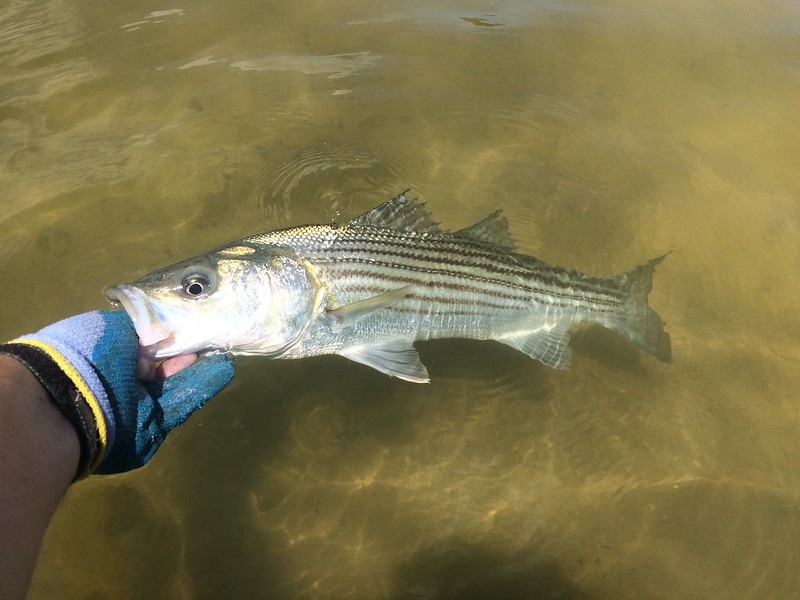Fishing for Conservation: Rules and Commonsense Tactics Protect Striped Bass
Here in Maryland’s section of the Chesapeake Bay, gamefish such as striped bass are under constant pressure both from fishing and large fluctuations in environmental conditions like high temperatures and low oxygen. Striped bass, known colloquially as rockfish, are Maryland’s state fish. Pursuing this fish for sport is a time-honored tradition, as is protecting them, ensuring striped bass remain in our waters for future generations to enjoy.
Anglers can take some pressure off striped bass by targeting invasive species like blue catfish and snakeheads, which we strongly encourage. But catch-and-release fishing for striped bass can be done safely or by practicing common sense tactics.
In the past few years, Maryland applied conservation measures by regulation. Anglers must use inline (non-offset) circle hooks whenever live-lining, chumming, or chunking in the Chesapeake Bay or its tidal tributaries from May 16 through Dec. 15. Circle hooks are designed to hook fish in the corner of the mouth, rather than be swallowed and do extensive internal damage. Even so, it’s essential angers use hooks that aren’t too small, or they can slip down past the gills into the gullet of the fish, defeating the purpose of using a circle hook. Larger circle hooks in the 8/0-9/0 range will be the most effective.
For those anglers using artificial lures and flies, circle hooks are not currently required, but there are some tackle modifications that you can do to release fish more quickly, which is better for their health. Most top-water poppers and swimming plugs have two or three sets of treble hooks. These trebles can be swapped out for barbless single hooks, using split rings to attach the hooks the lure. You may miss a few strikes, but the single hooks penetrate well and are much easier to handle with a thrashing rockfish at boatside. Anglers fishing with single-hook jigs and flies should crush the barbs on the hooks.
When releasing fish, be sure to keep your hands wet, and have appropriate de-hooking tools at the ready. Needle-nose pliers and other tools are at your local tackle shop. It’s important to minimize handling, and get the fish back into the water as fast as possible. Ideally, you should keep the fish in the water while de-hooking.
If you do bring the fish into the boat, never use a rag or towel to hold the fish. This will rub the protective slime layer and scales off the fish, making it more susceptible to disease. Striped bass can be held by the lower jaw (“lipped”) or cradled from underneath the belly. Larger stripers heavier than ten pounds should not be hung vertically by the lower jaw, since this could damage the jaw and internal organs.
Finally, be aware of environmental conditions that can affect the fish. During the hottest summer months, the Maryland Department of Natural Resources maintains a heat advisory system, an awareness campaign aimed to reduce striped bass mortality caused by heat stress. A color-coded recommendation system advises the public of fishing conditions, allowing anglers to plan their striped bass fishing trips up to seven days in advance.
On red days, air temperatures are forecast at 95 degrees or higher. Anglers are encouraged not to fish for striped bass after 10 a.m. and should target other species of fish, especially invasives. On yellow days, air temperatures are forecast at 90-94 degrees, and anglers should use extreme care when fishing for striped bass; fish should be kept in the water when caught and released on these days. On green days, fishing conditions are normal, although all proper catch-and-release practices should be observed.
Anglers are asked to continue checking the department’s website for updates to regulations and other tools to help conserve our aquatic wildlife. New information is always being added, so you can also follow our social media channels. Please stay tuned and don’t forget to share information with your angling friends.
More information is available at the Fishing and Boating Service general information line, 410-260-8300, or by sending an email to customerservice.dnr@maryland.gov.
dnr.maryland.gov/fisheries
Erik Zlokovitz is the Recreational Fisheries Outreach Coordinator for the Maryland Department of Natural Resources. Article appears in Vol. 23, No. 2 of the Maryland Natural Resource magazine, summer 2020.



 1-888-373-7888
1-888-373-7888 233733
233733